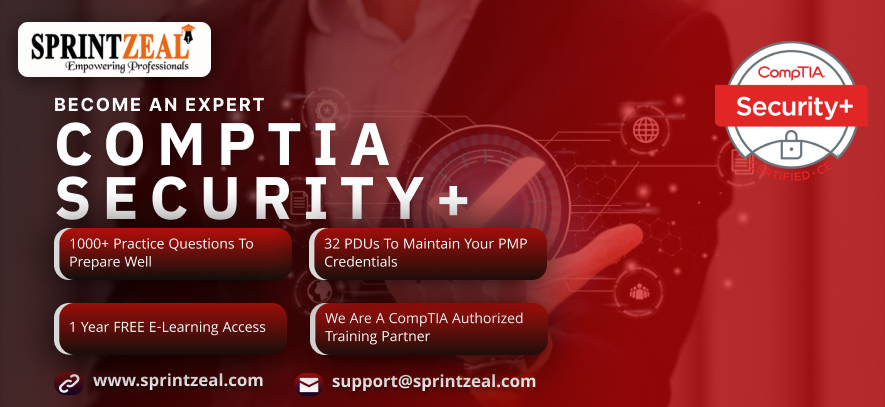The CompTIA Security+ certification is a globally recognized credential that validates the baseline skills necessary to perform core security functions and pursue an IT security career. Achieving this certification demonstrates your ability to secure networks, identify and mitigate security threats, and understand security protocols and policies. Preparing for the CompTIA Security+ exam requires a well-structured approach. This guide will provide you with a comprehensive roadmap to help you prepare effectively.
Understanding the Exam
The Security+ exam (SY0-601) covers a wide range of security-related topics. It’s important to familiarize yourself with the exam objectives, which include:
- Threats, Attacks, and Vulnerabilities (24%)
- Architecture and Design (21%)
- Implementation (25%)
- Operations and Incident Response (16%)
- Governance, Risk, and Compliance (14%)
Understanding the weightage of each domain helps you prioritize your study time effectively.
Study Resources
-
Official CompTIA Security+ Study Guide: Start with the official study guide provided by CompTIA. This guide covers all exam objectives and provides a solid foundation for your study.
-
Online Courses and Tutorials: Platforms like Udemy, Coursera, and LinkedIn Learning offer comprehensive courses for Security+. These courses often include video lectures, quizzes, and practice exams.
-
Books: Some recommended books include “CompTIA Security+ Certification All-in-One Exam Guide” by Mike Meyers and “CompTIA Security+ Study Guide” by Emmett Dulaney. These books provide in-depth coverage of exam topics and include practice questions.
-
Practice Exams: Practice exams are crucial for assessing your knowledge and exam readiness. Websites like ExamCompass and CertBlaster offer practice tests that simulate the real exam environment.
-
Online Forums and Study Groups: Joining forums and study groups on platforms like Reddit, TechExams, and LinkedIn can provide additional insights, study tips, and support from fellow exam takers.
Study Plan
Creating a study plan is essential for effective preparation. Here’s a sample study plan:
-
Week 1-2:
- Overview and Domain Familiarization: Read through the exam objectives and familiarize yourself with each domain.
- Basic Concepts and Terminology: Study basic security concepts and terminology. Use flashcards to reinforce your memory.
-
Week 3-4:
- Threats, Attacks, and Vulnerabilities: Dive deep into this domain. Understand different types of attacks (e.g., phishing, malware, ransomware) and their mitigation strategies.
- Practice Questions: Start attempting practice questions related to this domain.
-
Week 5-6:
- Architecture and Design: Study secure network design principles, cloud security, and secure systems design.
- Case Studies: Review case studies to understand the practical application of these principles.
-
Week 7-8:
- Implementation: Focus on identity and access management, secure protocols, and implementing security measures.
- Lab Exercises: Perform hands-on lab exercises to reinforce your understanding.
-
Week 9-10:
- Operations and Incident Response: Learn about incident response procedures, disaster recovery, and digital forensics.
- Mock Exams: Take full-length practice exams to assess your knowledge and timing.
-
Week 11-12:
- Governance, Risk, and Compliance: Study risk management, security policies, and compliance frameworks.
- Review and Revise: Review all domains, focusing on weak areas. Revisit practice questions and mock exams.
Practical Experience
Hands-on experience is invaluable for the Security+ exam. Set up a home lab using virtual machines (VMs) to practice various security tasks, such as:
- Setting Up a Firewall: Configure a firewall and test its effectiveness in blocking unauthorized access.
- Implementing VPNs: Set up a Virtual Private Network (VPN) and understand how it secures data transmission.
- Penetration Testing: Use tools like Metasploit to perform basic penetration testing and identify vulnerabilities.
- Incident Response Simulation: Simulate an incident response scenario and practice the steps involved in handling a security breach.
Exam-Taking Strategies
-
Time Management: The Security+ exam consists of 90 questions to be completed in 90 minutes. Practice time management to ensure you can complete all questions within the allotted time.
-
Read Questions Carefully: Pay attention to the wording of questions and options. Look out for keywords like “BEST” or “MOST” to identify the most appropriate answer.
-
Eliminate Wrong Answers: If you’re unsure about an answer, eliminate the clearly incorrect options first. This increases your chances of selecting the correct answer.
-
Flag Questions: Use the flag feature to mark questions you’re unsure about. If time permits, revisit these questions at the end.
-
Stay Calm and Focused: Maintain a calm and focused mindset during the exam. Take deep breaths if you feel anxious.
Post-Exam Steps
After completing the exam, take some time to reflect on your experience. If you pass, celebrate your achievement and consider the next steps in your career. If you don’t pass, review your performance, identify areas for improvement, and plan your retake strategy.
Continuing Education
The field of cybersecurity is constantly evolving. Stay updated with the latest trends, threats, and technologies by:
- Pursuing Advanced Certifications: Consider certifications like CISSP, CEH, or CISM to further enhance your credentials.
- Attending Conferences: Participate in cybersecurity conferences, webinars, and workshops to stay informed and network with professionals.
- Joining Professional Organizations: Become a member of organizations like (ISC)², ISACA, and CompTIA to access resources, training, and industry insights.
Conclusion
Preparing for the CompTIA Security+ certification exam requires dedication, structured study, and hands-on experience. By following this guide, utilizing available resources, and maintaining a disciplined study routine, you can enhance your chances of passing the exam and advancing your career in cybersecurity. Remember, the journey to certification is not just about passing the exam but also about building a solid foundation for a successful career in the ever-evolving field of cybersecurity.

